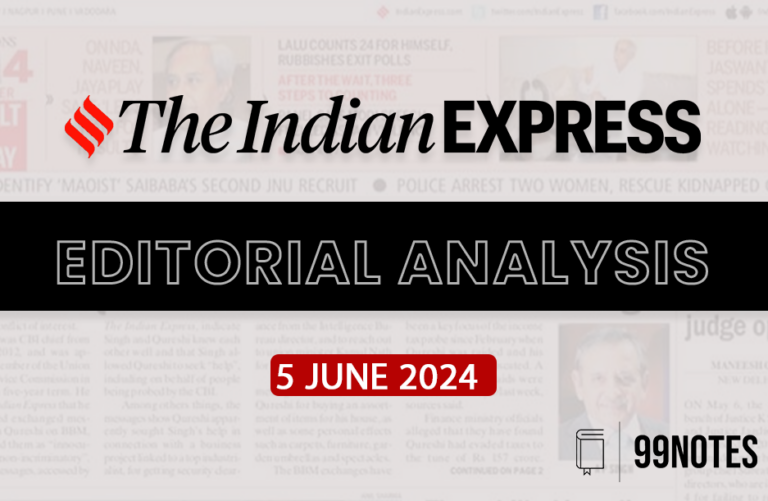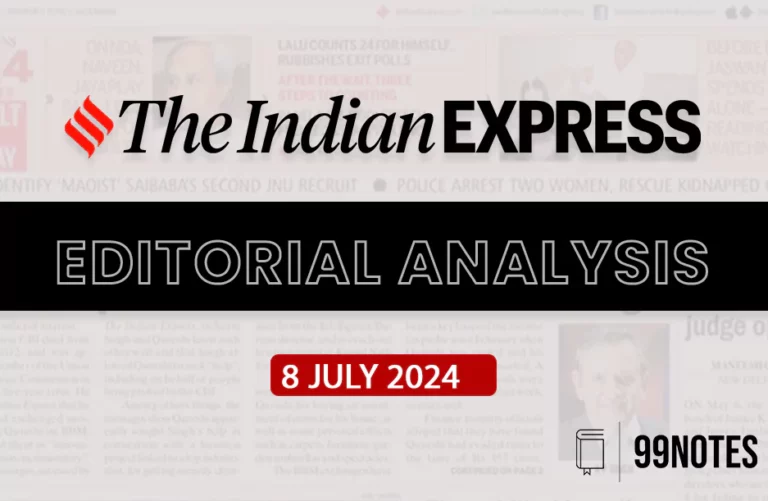3 Feb 2024 : Indian Express Editorial Analysis
Indian Express Editorial Analysis
3-February-2024
1. A reality check for budget
| Topic: GS3 – Indian Economy – Government Budgeting. This topic is relevant for both Prelims and Mains in the context of understanding the nuances of the budget and its impact on the economy |
| Context: |
|
More about the news:
Political Posturing and Lack of Major Announcements:
- Unlike the 2019 budget, which announced significant expenditure schemes, including the PM-KISAN with retrospective effect, the current budget refrains from major announcements.
- The government’s spending priorities exhibit a conservative outlook, contributing to a reduction in the fiscal deficit.
- However, the question remains whether these measures adequately tackle the pressing challenges faced by the Indian economy.
Rural Distress and Economic Realities:
- Despite claims of poverty reduction and economic rebound, the Indian economy grapples with severe rural distress, declining private investment, and employment challenges.
- The data on real wages, particularly in agriculture, underscores the economic hardships faced by workers.
- The reversal of the workforce transformation after 2017-18, with a surge in agricultural employment, signals deeper rural economic troubles.
Failure to Address Employment Quality and Incomes:
- The rise in female employment is overshadowed by an increase in self-employment, declining employment quality, and diminishing earnings for women workers.
- The budget’s failure to address the employment challenge, as seen in the increased number of workers returning to agriculture, contributes to declining cultivation income per worker, contradicting promises of doubling farmer incomes.
Neglect of Essential Spending and Decline in Social Welfare:
- The withdrawal of essential spending in crucial sectors like agriculture, rural development, education, and health, amid a struggling rural economy, declining incomes, and looming inflation, exacerbates the challenges faced by the majority of the population.
- Budget estimates for major heads show stagnation or decline in real terms, with a focus on cash transfers and subsidies rather than real investments.
Impact on Consumption Demand and Economic Growth:
- Despite an increase in government transfers over the last five years, consumption demand has failed to respond, with real incomes remaining lower than 2018-19 levels.
- The sluggish consumption growth poses a concern, and challenges persist in private investment and exports, requiring sustained government support.
- However, the budget’s spending priorities seem more geared towards long-term promises than immediate provisioning.
Conclusion:
- The pre-election budget reflects an acceptance of the limitations of public expenditure, evidenced by cutbacks in social welfare spending.
- The neglect of critical sectors like agriculture and rural development is likely to push the rural economy into distress, hindering the revival of overall economic demand and private sector investment.
- Unfortunately, the budget falls short of providing a true reflection of the economy’s state or outlining a comprehensive future governance agenda.
| What is Interim Budget? |
|
| PYQ: One of the intended objectives of Union Budget 2017-18 is to ‘transform, energize and clean India’. Analyse the measures proposed in the Budget 2017-18 to achieve the objective. (250 words/15m) (UPSC CSE (M) GS-3 2017) |
| Practice Question: Discuss the implications of the recent pre-election budget on the Indian economy, focusing on its impact on rural distress, declining private investment, and employment challenges. (150 words/10 m) |
2. The future of water
| Topic: GS3 – Environment – Conservation This topic is relevant for Mains in the context of water scarcity, climate change impact, and the potential commodification of water. |
| Context: |
|
More about the news:
Water as a Commodity: Concerns and Critiques:
- The CME Group’s introduction of the water futures contract aimed at managing risk and balancing water supply and demand has raised eyebrows.
- Critics, including UN Special Rapporteur Pedro Arrojo-Agudo, express apprehension, arguing that treating water as a tradable commodity akin to gold or oil risks marginalizing vulnerable sectors, particularly small-scale farmers.
- The concerns are rooted in the fear that hedge funds, banks, and large industrial players may exploit water trading, potentially undermining its status as a public good.
Water Scarcity: A Unique Challenge:
- Unlike conventional commodities, water scarcity results from factors such as overuse of groundwater, climate change, and rapid urbanization.
- The UN’s 2023 World Water Development Report highlights that a significant portion of the global population lacks access to safe drinking water, with India facing a critical water-stress situation.
- As water scarcity intensifies, questions arise about controlling access, preventing privatization, and ensuring affordability, particularly for vulnerable populations.
Constitutional Safeguards and Water Distribution:
- The Indian Constitution addresses water-related concerns, emphasizing the importance of equitable distribution.
- Article 262 empowers Parliament to adjudicate inter-State water disputes, leading to the enactment of the Inter-State Water Disputes Act, 1956.
- The judiciary, notably in cases like the Cauvery water disputes, has played a vital role in determining water allocation.
- The Constitution, through Article 21, recognizes the right to clean water as part of the right to life, establishing a fundamental right for every Indian to access safe and clean water.
Water Pricing and Constitutional Principles:
- In India, water pricing is determined by individual states, guided by their municipal frameworks.
- However, constitutional principles, particularly Article 39 in the Directive Principles of State Policy, emphasize the need to distribute material resources for the common good.
- This constitutional safeguard may serve as a bulwark against pricing water beyond the reach of the average Indian, providing a counterbalance to potential privatization efforts.
The Privatization Debate: Balancing Access and Affordability:
- The push for water sector reforms, often synonymous with privatization, raises concerns about affordability and equitable access.
- The analysis explores the implications of such reforms, including tariff increases, retrenchment, full-cost recovery, and public-private partnerships.
- Emphasizing the constitutional protection of water as a natural resource, the article advocates for a balanced approach that ensures water remains accessible to all, aligning with the larger common good.
Conclusion:
- As the global water landscape evolves with the emergence of water futures trading, the analysis concludes by emphasizing the need for a cautious approach.
- Balancing the economic aspects of water trading with the constitutional principles of equitable distribution and accessibility is crucial to prevent water from becoming an unaffordable commodity.
- The constitutional safeguards, coupled with responsible governance, can shape the future of water as a protected natural resource, ensuring its availability for the larger common good.
| UN’s 2023 World Water Development Report |
Major findings of the report:
Recommendations:
|
| PYQ: With reference to ‘Water Credit’, consider the following statements: (2021) 1) It puts microfinance tools to work in the water and sanitation sector. 2) It is a global initiative launched under the aegis of the World Health Organization and the World Bank. 3) It aims to enable the poor people to meet their water needs without depending on subsidies. Which of the statements given above are correct? (a) 1 and 2 only (b) 2 and 3 only (c) 1 and 3 only (d) 1, 2 and 3 Ans: (c) |
| Practice Question: Evaluate the ethical considerations surrounding the commodification of water and its potential impact on equitable access. (150 words/10 m) |
For Enquiry

13 February 2024 : The Hindu Editorial Notes PD

13 Feb 2024 : Indian Express Editorial Analysis

13 February 2024 : PIB Summary for UPSC

12 Feb 2024 : Daily Current Affairs Quiz

12 Feb 2024 : Daily Answer Writing

12 Feb 2024 : Daily Current Affairs

12 Feb 2024 : Indian Express Editorial Analysis

12 February 2024 : The Hindu Editorial Notes PDF

12 February 2024 : PIB Summary for UPSC

10 Feb 2024 : Daily Current Affairs Quiz
Feb 2024 The Hindu 13 February 2024 : The Hindu Editorial Notes PD The Hindu Editorial
13-February-2024
1. A global alliance to bridge the gender equity gap
Topic:…
Indian Express 13 Feb 2024 : Indian Express Editorial Analysis Indian Express Editorial Analysis
13-February-2024
1. A science for us
Topic: GS2 – Governance…
feb 2024 PIB 13 February 2024 : PIB Summary for UPSC PIB Summary for UPSC
13-February -2024
1. Union Minister G Kishan Reddy inaugurate regional centre…
Daily Quiz 12 Feb 2024 : Daily Current Affairs Quiz 12 Feb 2024 : Daily Quiz…
mains answer writing 12 Feb 2024 : Daily Answer Writing Mains Answer Writing
12-February-2024
Q1) “Water scarcity threatens economic and social gains…
Daily Current Affairs 12 Feb 2024 : Daily Current Affairs Daily Current Affairs
12-February-2024- Top News of the Day
1. Great Indian Bustards give Nandyal a…
Indian Express 12 Feb 2024 : Indian Express Editorial Analysis Indian Express Editorial Analysis
12-February-2024
1. CLASSROOM VS COACHING
Topic: GS2 – Social…
Feb 2024 The Hindu 12 February 2024 : The Hindu Editorial Notes PDF The Hindu Editorial
12-February-2024
1. A privileged strategic partnership, without a gulf
Topic:…
feb 2024 PIB 12 February 2024 : PIB Summary for UPSC PIB Summary for UPSC
12-February -2024
1. Birth anniversary of Swami Dayanand Saraswati
Topic:…
Daily Quiz 10 Feb 2024 : Daily Current Affairs Quiz 10 Feb 2024 : Daily Quiz…




